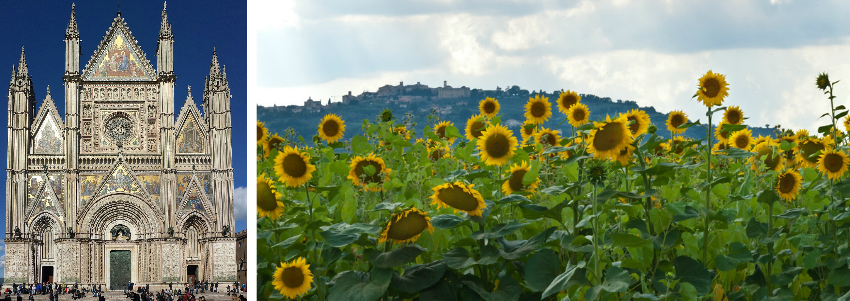Orvieto, I Can’t Wait to Meet You
On my way to checking one more experience off my bucket list.
Umbria your green hills and lush valleys have called me back since I first roamed through your rich bounty back in 2004. I’m eager to bicycle through your quaint Medieval cities, savor your world renowned wines, cheeses and olive oils. Sunflowers get ready, I am coming! Together our cheery upturned faces will track the sun across the horizon. Umbria your treasures are innumerable but there is one gem in your weighty crown that is at the top of my list – it is called Orvieto and its world-famous underground city is about to be crossed off my bucket list.
ExperiencePlus!’s bicycle tour across Umbria includes enough highlights (Spoleto, Trevi, Bevagna, Assisi, Montefalco, Deruta, Perugia, Todi, and Civita de Bagnoregio) to satiate the most ferocious traveler’s appetite. But above all, Orvieto has stolen my imagination. For starters, you can take an escalator, elevator, or my favorite, a funicular to reach the old city. Sitting more than 1000 feet atop a spectacular tabletop of volcanic bedrock, you can look out on quintessential Italy, picturesque hillsides covered in vineyards, cypress and olive trees. Tuscany may have co-opted the moniker “hill-top town,” but Orvieto is one of the oldest cities in Italy and had to be the prototype. It just doesn’t get any more classic “hilltop” or Italian than this.
More than just a pretty face, there is complex history beneath the surface. Orvieto has an improbable underground world which offers a glimpse into the city’s storied past. Many of the chambers, which predate the Etruscan civilization, were used as wine cellars. One of the most impressive features of this underground city is Pozzo di San Patrizio, or St Patrick’s Well which was dug by order of Pope Clement VII de’Medici. Over 175 feet deep, this remarkable well meant that the people (and the pope) would have water in times of siege. The caverns also had a significantly sized pigeon coop and you’ll still find pigeon (piccione) dishes at restaurants in Orvieto. Explorers of this massive underground world delighted in the discovery of a complete medieval olive press including millstones, press, furnace and mangers for the animals that worked the grindstones. Food, wine, water and olive oil storage meant that the city was able to withstand invaders for years at a time – hopefully with a glass of the renowned Classico white wine in hand, and ideally with a view of the Duomo.
Orvieto has a host of treasures including the Duomo which took 30 years to plan and three centuries to construct. The interior features frescoes by Luca Signorelli whose work inspired a young Michelangelo. In a few weeks I will finally see these gems with my own two eyes. And though the city and its surroundings are known for their beauty, I can’t wait to dive beneath their surface and discover buried treasures.
Read more about Bicycling Verdant Umbria! Plus! Todi and Orvieto.


